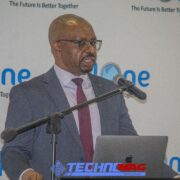By Ross Moyo
Mutapa Investment Fund’s committed to providing funding for the roll out of Phase 1 of the Home-Grown Smart Electronic Traffic Management System (ETMS), targeting 20 sites in Harare.
Formerly Zimbabwe’s Sovereign Wealth Fund and now upgraded to Mutapa Investment Fund covering many State Entities especially all the Telcos including TelOne, NetOne and POSB amongst many others gives Mutapa potential involvement in the Smart Traffic Management System, according to government spokesperson Nick Mangwana who was recently quoted confirming “Mutapa Investment Fund has committed to providing funding for the roll out of Phase 1 of the Home-Grown Smart Traffic Management System, targeting 20 sites in Harare.”
According to Mangwana and his boss in a recent Cabinet briefing, “this is a Government project, implemented by a quasi-government entity (TelOne) and funded by a quasi-governmental entity (Mutapa).”
With Zimbabwe’s teleconvergence operator implementing what Mutapa is funding, there should be no room for doubting the feasibility of the Home-Grown Smart Traffic Management System.
With Mutapa’s financial muscle, infrastructure initiatives can transition from conceptual stages to tangible realities instilling confidence in the potential of the Smart Traffic Management System.
This system’s national project status underscores its strategic importance and potential impact on the nation’s development whose designation will facilitate prioritisation, expedite implementation and ensure the allocation of necessary resources by Mutapa Investment Fund.
The Zimbabwe Government and Zimbabwe Republic Police (ZRP) have also joined hands in gloves for this electronic traffic management system (ETMS).
ZRP, government departments are partnering to develop this smart Electronic Traffic Management System to reduce road carnage and lawlessness
Cabinet recent address showed commitment towards reducing road lawlessness and carnage, hence the Zimbabwe Republic Police partnering various government departments to develop a comprehensive Electronic Traffic Management System (ETMS).
In Response to questions raised by the Transport and Infrastructure Development Parliamentary Portfolio Committee members recently, Home Affairs Secretary, Ambassador Tayerera Faranisi said the The post Police, government departments partner to develop smart Electronic Traffic Management System to reduce road carnage and lawlessness.
Electronic Traffic Management System fully funded by Mutapa as a project is poised for success, and its benefits will soon be felt across the country.
The Smart Traffic Management System is a win-win solution for Zimbabwe. On one hand, it will significantly reduce the number of lives lost or limbs maimed on our roads, particularly due to the reckless behaviour of some kombi drivers. The carnage on our roads has been a national concern, and this system will help bring much-needed discipline to our transportation sector.
The system on the other hand will also have a positive impact on the economy. The insurance industry has been struggling to operate profitably in Zimbabwe due to the high number of premature claims resulting from road accidents.
Smart Traffic Management System in place, will ensure the number of accidents expected to decrease, making it more viable for insurance companies to operate. Those who continue to drive irresponsibly will face the financial consequences of their actions, and it will be a case of self-inflicted financial hardship.
This Smart Traffic Management System will also collect valuable data on traffic volumes and patterns, which will inform the planning and construction of Zimbabwe’s roads.
Such data collected via the ETMS will enable authorities to design and build roads that are tailored to the specific needs of each area, reducing congestion and improving safety. By leveraging this data, Zimbabwe can create a more efficient and effective transportation infrastructure, which will have long-term benefits for the economy and the general public.
Smart Traffic Management System towers as a beacon of hope in Zimbabwe’s fight against corruption, especially in the traffic management sector.
Automating the detection and enforcement of traffic infractions, will see the system significantly reduce the potential for human intervention, thereby minimising opportunities for corrupt practices as given the prevalence of corruption in Zimbabwe, mainly in areas with human interface, the system’s automated nature makes it nearly corruption-proof, ensuring a fairer and more transparent enforcement of traffic laws.
Such innovative solution deserves widespread applause. Only those who flagrantly disregard road traffic rules and corrupt officers who exploit the public should be concerned. Law-abiding citizens should rally behind this initiative, which brings much-needed order to our roads. While technology can enhance road safety, it’s up to motorists and road users to cultivate good manners and courtesy on the roads.
Such qualities are not taught by technology, but rather instilled through empathy and responsible behaviour. By embracing this initiative and adopting a culture of respect and consideration, Zimbabwe is poised to transform its death trap roads into a pleasure to drive on.
Smart Traffic Management, according to government mouthpiece is just what the doctor ordered as the country’s urban roads, particularly in cities like Harare, have devolved into a chaotic nightmare, testing the patience of motorists and pedestrians alike.
Usual roadblocks and manual traffic management methods, while well-intentioned, have proven woefully inadequate in taming the traffic beast hence a more intelligent approach is needed to untangle the gridlock and ensure smoother flow of traffic.
Cabinet on June 17, 2025, gave the green light to accelerate the Home-Grown Smart Traffic Management System under the Safe City Project, spearheaded by TelOne.
The development starts a new era in traffic management, one that leverages technology to bring order and efficiency to the Southern African country’s roads.
Cabinet approval of the Home-Grown Smart Traffic Management System under the Safe City Project is a welcome respite, particularly for Harare and Bulawayo’s beleaguered roads as road safety is a grave public concern, and traditional methods have fallen short.
Information Communication Technology (ICT) leveraging is a globally recognised best practice to curb road lawlessness and enhance safety. This initiative will not only improve road safety but also support the justice delivery system, enhance governance and boost public safety.
Technologies like the Internet of Things (IoT), Artificial Intelligence (AI) and big data analytics, must be harnessed so that the Smart Traffic Management System modernizes traffic management, improve revenue collection and build law enforcement capacity. Key components include a Command-and-Control Centre, cameras with Automatic Number Plate Recognition technology and AI-based video analytics.
The system will predict traffic patterns, optimise signals and provide mobile and public interfaces for fine payment.
Such an initiative demonstrates Government’s commitment to effective governance and public safety and is a step in the right direction towards taming Harare’s chaotic roads.
Mutapa Investment Fund’s TelOne solution deserves commendation for being a homegrown initiative ensuring Zimbabe unique needs and challenges are addressed by solutions tailored to its context and by investing in local innovation, the SADC chairing nation will keep financial resources within the country, stimulating economic growth and development.
A homegrown solution like TelOne’s Smart Traffic Management System showcases the prowess of Zimbabwean education and skill sets, demonstrating that its expertise is more than capable of addressing local problems.
The approach also prioritises national security considerations, including data sovereignty, ensuring that sensitive information remains protected and under our control. By embracing local solutions, we are building a more self-sufficient and resilient nation.
This Smart Traffic Management System’s implementation is a strategic fit for Zimbabwe’s unique challenges, aligning perfectly with the country’s Education 5.0 model which emphasises innovation, research and community engagement, all of which are integral to the system’s locally driven approach.
Utilizing local expertise and resources, fosters knowledge transfer, skills development and national pride, promoting self-reliance and sustainability.
This localised approach also offers practical benefits, enabling rapid implementation at a relatively lower cost, facilitating community buy-in and mobilizing local resources, which in turn enhances confidence in the local financial landscape. By investing in homegrown solutions, Zimbabwe is contributing to its own economic development, showcasing a commitment to harnessing local talent and resources to drive progress.
This Home-Grown Smart Traffic Management System has made significant strides, showcasing impressive capabilities in its Proof-of-Concept demonstration for example the ability to identify vehicle owners through integrated databases with ZINARA and CVR, notify violators and enable them to review evidence of offences.
This detects various traffic infractions, including red-light infractions, speeding, disobeying stop signs and improper lane changes, among others. These are the very things that cause traffic chaos, especially when it’s raining and the system’s advanced features include compatibility with various image capture devices, a modular structure for phased implementation and high availability with built-in redundancy and fail-safe mechanisms. This enables real-time data processing and analysis, collecting rich traffic data for advanced analytics.
This system can also be configured for crime management functions, such as crowd detection, pickpocketing detection and loitering detection, making it a versatile tool for enhancing public safety and security hence by sneeking at pickpocketing this solution goes beyond traffic safety.
The system will be implemented in a phased way, with Harare, Bulawayo, Mutare, Gweru, Masvingo and other urban centres like Chinhoyi, Kadoma and Victoria Falls standing to benefit.
Mutapa investment Funding phased approach to the Smart Traffic Management System’s roll out allows for adaptability and refinement as the project progresses.
Implementing the system in stages, will help the project team test and refine the system in initial locations, identify and address challenges or areas for improvement, generate revenue from the initial roll out and use this revenue to fuel further growth and deployment in subsequent phases, enabling the project to mitigate risks, optimise system performance and expand operations efficiently, ultimately ensuring sustainability through self-generated funding. Through leveraging revenue generated from early phases, the project can scale up and reach more areas without relying heavily on external funding, promoting long-term viability.













Comments